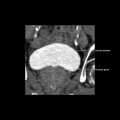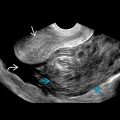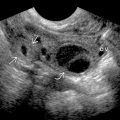GROSS ANATOMY
Overview
- •
Intraperitoneal lymphatic organ located posterior to stomach and intimately associated with retroperitoneum (pancreatic tail and left kidney)
- •
Surrounded by peritoneum (except at hilum) and suspended by several ligaments
- ○
Gastrosplenic ligament
- –
Left anterior margin of lesser sac
- –
Connects spleen to greater curvature of stomach
- –
Carries short gastrics and left gastroepiploic arteries and venous branches to spleen
- –
- ○
Splenorenal ligament
- –
Left posterior margin of lesser sac
- –
Connects spleen to left kidney and pancreatic tail
- –
Carries splenic artery and vein to splenic hilum
- –
- ○
Splenocolic ligament: Between spleen and splenic flexure of colon
- ○
Splenophrenic ligament: Between spleen and inferior surface of diaphragm
- ○
- •
Normal size is variable ; no universal consensus
- ○
Generally, normal adult spleen considered 12-cm length x 7-cm width x 4cm thickness
- –
Length = longest diameter in longitudinal plane; width = longest transverse (anterior-posterior) diameter; thickness = maximal thickness in transverse plane at hilum
- –
- ○
Splenic index (product of length, thickness, and width): Normally 120-480 cm³
- ○
Size correlates with height and can exceed these limits in tall, healthy people
- ○
- •
Functions
- ○
Manufactures lymphocytes, filters blood (removes damaged red blood cells and platelets)
- ○
Acts as blood reservoir: Can expand or contract in response to changes in blood volume
- ○
- •
Histology
- ○
Soft organ with fibroelastic capsule and comprised of pulp
- –
White pulp: Lymphoid nodules/tissue primarily surrounding vasculature
- –
Red pulp: Sinusoidal spaces containing blood
- –
- ○
Trabeculae: Extensions of capsule into parenchyma; carry arterial and venous branches
- ○
Splenic cords (plates of cells) lie between sinusoids; red pulp veins drain sinusoids
- ○
- •
Vasculature
- ○
Splenic artery arises from celiac axis in > 90%; 8% directly from aorta
- –
Often very tortuous
- –
- ○
Splenic vein runs in groove along dorsal surface of pancreatic body and tail
- –
Receives inferior mesenteric vein (IMV)
- –
Combined splenic vein and IMV join superior mesenteric vein to form portal vein
- –
- ○
IMAGING ANATOMY
Overview
- •
Homogeneous echogenicity
- ○
Echogenicity: Pancreas > spleen > liver > kidney
- ○
Radiating pattern of segmental arteries and veins
- ○
- •
Splenic artery
- ○
Low-resistance waveform; tortuosity of vessel results in turbulence and spectral broadening
- ○
Normal diameter: 4-8 mm; peak systolic velocity (PSV): 25-45 cm/s
- ○
Retrograde flow can be seen in setting off celiac trunk occlusion
- ○
- •
Splenic vein
- ○
Normal diameter: 5-10 mm; PSV: 9-18 cm/s
- ○
Splenic vein at midline is useful landmark for locating pancreas
- –
Pancreas lies anterior to splenic vein
- –
- ○
Diameter increases between 50-100% from quiet respiration to deep inspiration; increase of < 20% suggests portal hypertension
- ○
Spectral Doppler waveform typically shows band-like flow profile with minimal respiratory fluctuations
- ○
ANATOMY IMAGING ISSUES
Imaging Recommendations
- •
Patient positioned supine or right decubitus position (left side up) with left arm raised
- •
Place transducer parallel to ribs in 10th or 11th intercostal space at left midaxillary line, searching for best window
- ○
Due to rib angle, this results in oblique view, which by convention is called longitudinal or transverse (depending on transducer orientation)
- ○
Transverse US view of spleen does not correlate directly to axial CT view
- ○
- •
End expiration may be helpful; lung base may obscure spleen in full inspiration
- •
Spleen poorly accessed from posterior (obscured by left lung base), anterior, or subcostal approach (obscured by stomach and colon)
- •
Assess splenic vein at hilum and midline for patency and flow direction
- •
Can use spleen as acoustic window to visualize tail of pancreas
- •
Left lobe of liver may extend superior to the spleen and should not be mistaken for splenic lesion
Key Concepts
- •
Spleen has highly variable size and shape
- ○
Easily indented and displaced by masses and even loculated fluid collections
- ○
Imaging reliably detects splenomegaly and may suggest its cause (whether diffuse or due to space occupying lesion; extrasplenic clues, e.g., with cirrhosis = portal hypertension; with lymphadenopathy = lymphoma, mononucleosis, etc.)
- ○
- •
Spleen is commonly injured in blunt trauma, especially with fracture of left lower ribs
- ○
Parenchymal laceration and capsular tear often result in substantial intraperitoneal bleeding
- ○
EMBRYOLOGY
Practical Implications
- •
Accessory spleen (splenunculus, splenule)
- ○
Found in 10-30% of population and may be multiple
- ○
Usually small, near splenic hilum
- ○
Can enlarge and simulate mass, especially after splenectomy
- ○
Ectopic intrapancreatic splenule can mimic pancreatic tail mass; should not be > 3 cm from tail tip
- ○
- •
Wandering spleen : Spleen may be on long mesentery
- ○
Found in any abdominopelvic location; risk of torsion
- ○
- •
Asplenia and polysplenia (heterotaxy syndromes)
- ○
Rare congenital conditions of altered left/right orientation of organs
- ○
Associated with cardiovascular anomalies, intestinal malrotation, etc.
- ○
- •
Splenosis : Peritoneal implantation of splenic tissue after traumatic splenic injury, can mimic polysplenia
LIGAMENTS AND VESSELS










